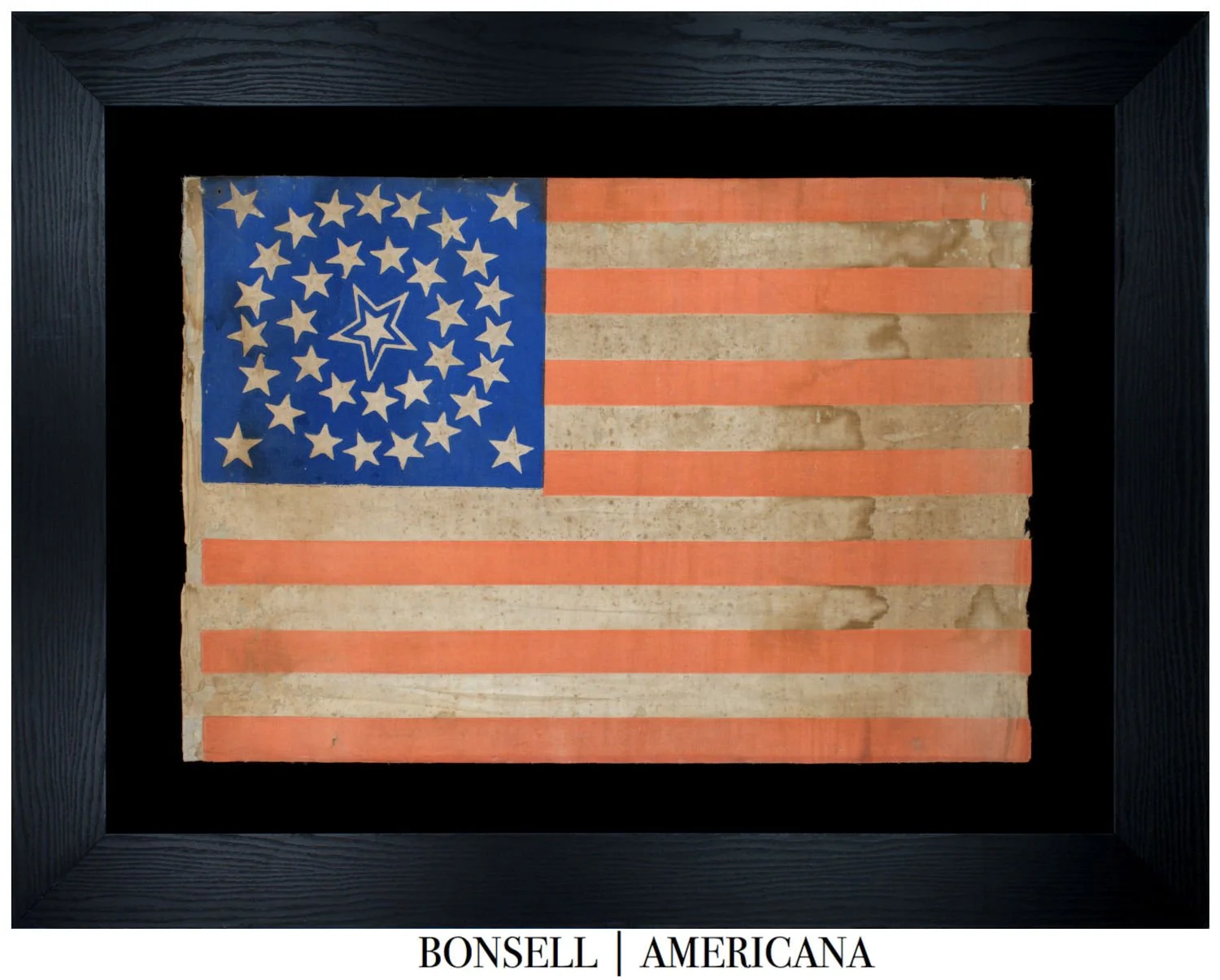Ohio State Flag with Civil War Veteran’s Memorial Overprint | Made to Commemorate Daniel M. Hall, National Commander of the Grand Army of the Republic, and His Legacy of Service | Circa 1925
Ohio State Flag with Civil War Veteran’s Memorial Overprint | Made to Commemorate Daniel M. Hall, National Commander of the Grand Army of the Republic, and His Legacy of Service | Circa 1925
Frame Size (H x L): 17” x 13”
Flag Size (H x L): 4” x 6” on a 10” Staff
Offered is an Ohio state flag, dating to 1925. It is an exceptional artifact of historical significance, crafted to honor the life and legacy of Daniel M. Hall, a celebrated Civil War veteran and National Commander of the Grand Army of the Republic (“GAR”). Made from plain weave cotton, the flag reflects the practical materials commonly used for commemorative items of the period. The cotton is treated with a finish to make it more durable and water-resistant, mimicking the qualities of oilcloth.
Its distinctive swallowtail design, featuring vibrant red, white, and blue elements, mirrors the official Ohio state flag adopted in 1902, a design inspired by Civil War cavalry guidons. Mounted on its original wooden staff, this flag was intended for ceremonial use, serving as a reminder of Hall’s legacy.
What elevates this flag’s historical importance is its overprint, stamped in black ink on the striped field. Enclosed within a laurel wreath, the inscription reads, “GAR Post, Dan Hall, Columbus, OH,” directly tying the flag to the GAR and specifically commemorating Hall’s death in 1925, just before his 83rd birthday. Flags with overprints dedicated to specific individuals are rare, making this an especially coveted piece for collectors.
The GAR, founded in 1866, was one of the most influential veterans’ organizations in American history. Dedicated to uniting Union Civil War veterans, the GAR blended social fellowship with political advocacy. Members, often called “comrades,” donned their wartime uniforms to march in parades, participate in reunions, and advocate for veterans’ benefits such as pensions. The organization also played a central role in establishing Memorial Day as a national holiday. Structurally, the GAR mirrored the military, with local “posts” acting as chapters under the leadership of state and national commanders. By fostering a sense of brotherhood and preserving the memory of Union service, the GAR had a profound impact on postwar society and veterans’ rights.
Daniel M. Hall exemplified the dedication and leadership of the GAR’s membership. Born on October 20th, 1842, Hall served with distinction in the 2nd and 12th Ohio Cavalry regiments during the Civil War. After mustering out in 1865, he became deeply involved in veterans’ affairs, joining the Hamlin Post of the GAR in Columbus, Ohio, in 1883. Hall’s organizational skills and leadership propelled him to prominence, ultimately serving as the Commander of the Ohio Department and later as National Commander-in-Chief. His efforts focused on preserving the bonds of fellowship among veterans and honoring their sacrifices. Hall’s passing in 1925 marked the loss of a respected leader, memorialized through artifacts like this flag.
The Hamlin Post, based in Columbus, was among many GAR chapters that served as vital centers for veterans’ social and charitable activities. Posts like Hamlin provided support to veterans and their families, organized community events, and preserved the shared memory of Union service. Under Hall’s leadership, the Hamlin Post became an integral part of the GAR’s Ohio Department, further elevating its historical significance. The creation of this overprinted flag in Hall’s memory underscores the deep respect he commanded within the organization and the lasting impact of his contributions.
The Ohio state flag itself, adopted in 1902, is among the most distinctive in the United States. Designed by Cleveland architect John Eisenmann, it was created for the Pan-American Exposition in Buffalo, New York, in 1901. Its unusual swallowtail shape sets it apart, drawing inspiration from both Civil War-era cavalry guidons and maritime burgees. This shape, along with its bold and symbolic design, captures the spirit of Ohio’s heritage and geography. At its center is a red disc set within a white circular field, representing the letter “O” for Ohio and the buckeye, the state’s iconic symbol. Five alternating red and white stripes symbolize the state’s waterways and roads, while the blue triangular field, representing hills and valleys, features 17 stars: 13 for the original colonies and four more to signify Ohio’s admission as the 17th state.
This symbolic depth, paired with its unconventional design, ensures the Ohio flag’s enduring appeal. Over the decades, it has been a source of pride for the state and its citizens, appearing in civic ceremonies and historical commemorations alike. The flag’s resemblance to Civil War guidons serves as a reminder of Ohio’s significant contributions to the Union during the Civil War, while its design elements reflect the state’s natural and cultural heritage. Together, the Ohio flag and artifacts like this overprinted version serve as emblems of the state’s history and the lasting legacy of its citizens.
Conservation Process: This flag was hand sewn to cotton fabric, and both were hand sewn to a mounting board. To prevent the black dye in the cotton fabric from seeping into the flag, it was first washed in a standard wash and then in a dye setting wash. The flag is positioned behind Optium Museum Acrylic.
Frame: The frame is made of walnut and dates from 1860 to 1890. Its dark wood and simple craftsmanship reflect the style of the period.
Condition Report: The flag is in remarkably clean and well-preserved condition, with vibrant colors and minimal signs of wear. Only a few faint yellow stains are visible, adding subtle character while not detracting from its overall appearance.
Collectability Level: The Great – Perfect for Rising Collectors
Date of Origin: 1925









